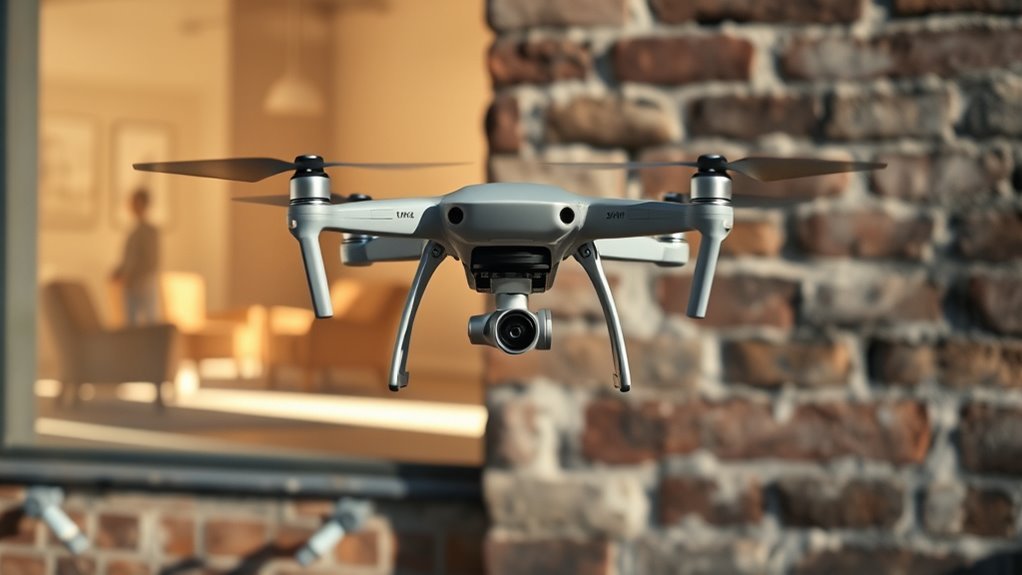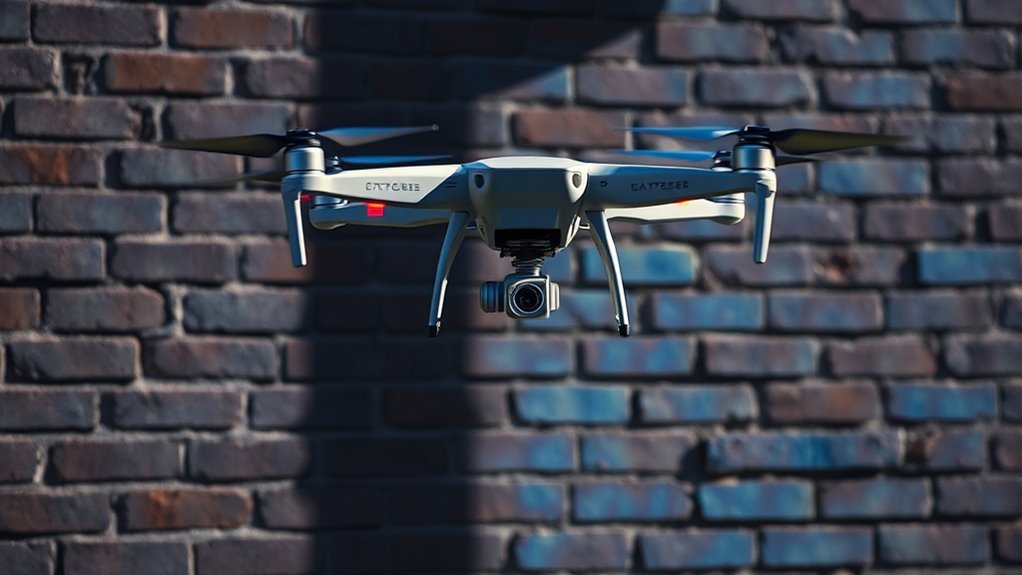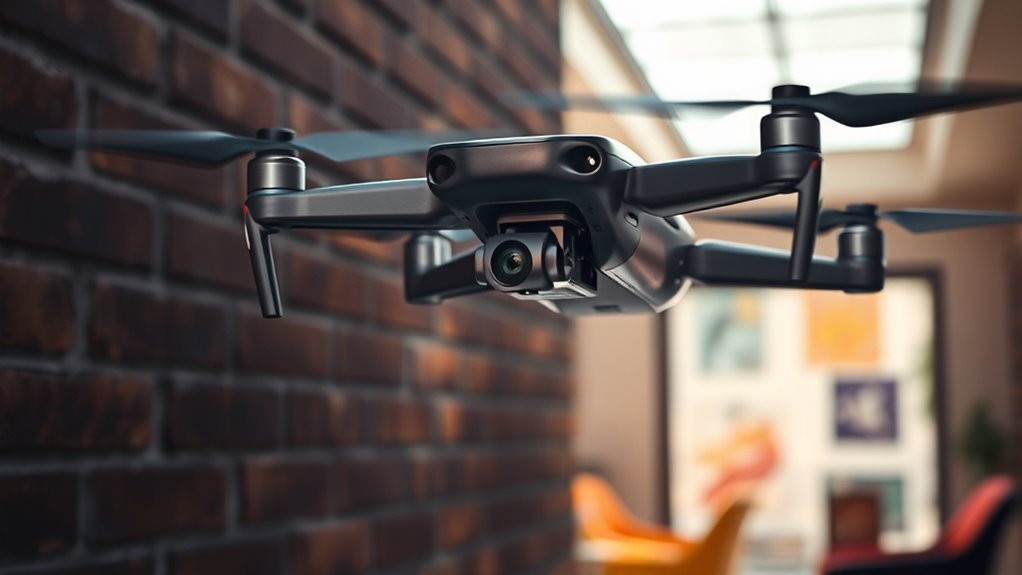If you rely on drones to see through walls, you’ll face significant limits due to signal attenuation by dense materials like concrete and metal that absorb and scatter signals. Thermal imaging struggles with solid barriers and can be disrupted by weather, while radar resolution decreases with distance and frequency trade-offs. Electromagnetic interference and environmental noise degrade sensor accuracy. Furthermore, legal and ethical restrictions shape data use. Understanding these constraints is essential before deploying such technology in real settings.
Physical Barriers and Signal Attenuation

Although drones rely heavily on wireless communication for control and data transmission, physical barriers considerably impede signal strength and reliability. When you operate a drone near walls, buildings, or dense materials, signal attenuation occurs as electromagnetic waves lose energy penetrating these obstructions. Physical barriers like concrete, metal, and thick foliage absorb and scatter signals, reducing effective range and data throughput. This attenuation directly limits your drone’s ability to maintain stable connections, causing latency or loss of control. Understanding these constraints is vital if you want to maximize operational freedom without risking disconnection. You must account for material composition and barrier density since they determine the extent of signal degradation, forcing you to strategize flight paths that minimize interference and sustain reliable wireless communication essential for precise drone navigation and data acquisition.
Challenges With Radar Technology

You’ll face significant challenges with radar technology when signal penetration is limited by environmental factors, reducing detection capabilities. Resolution constraints can impair your ability to distinguish small or closely spaced objects, affecting operational accuracy. Additionally, interference and noise from external sources can degrade signal quality, complicating reliable data interpretation.
Signal Penetration Issues
When operating drones in complex environments, signal penetration issues pose significant challenges to radar technology. You’ll encounter signal degradation as electromagnetic waves struggle to pass through dense materials like concrete or metal. This degradation reduces the effective range and accuracy of radar systems. Frequency limitations further complicate this issue; lower frequencies penetrate walls better but offer less detailed information, while higher frequencies provide finer data but suffer from greater attenuation. You must balance these trade-offs, understanding that no single frequency can fully overcome penetration challenges without compromising signal quality. These constraints restrict your ability to reliably detect objects behind barriers, limiting operational freedom. Addressing signal penetration requires careful selection of radar frequencies and system design to mitigate degradation effects while maintaining practical surveillance capabilities.
Resolution and Clarity Limits
Even if signal penetration challenges are addressed, radar technology still faces inherent resolution and clarity limits that affect drone performance. These resolution limitations restrict your ability to distinguish closely spaced objects behind walls, while clarity challenges reduce image fidelity, complicating reliable interpretation. The physics of radar waves and antenna design impose strict boundaries on achievable resolution, forcing trade-offs between range and detail.
| Factor | Impact on Drone Imaging |
|---|---|
| Wavelength | Longer wavelengths lower resolution |
| Antenna Size | Smaller antennas limit clarity |
| Signal Bandwidth | Narrow bandwidth reduces detail |
| Target Distance | Greater distance degrades resolution |
Understanding these constraints is crucial if you want drones to offer accurate, actionable data without sacrificing freedom of operation.
Interference and Noise Challenges
Although advancements in radar technology have improved drone sensing capabilities, interference and noise remain significant obstacles that can degrade signal integrity and obscure vital data. You’ll encounter various interference sources, including electromagnetic emissions from nearby electronics, structural materials, and environmental reflections, all of which complicate accurate wall penetration. Effective noise reduction techniques, such as adaptive filtering and signal processing algorithms, are essential to isolate meaningful radar returns from background clutter. However, these methods have limits; excessive noise can mask subtle signal variations necessary for reliable detection. Recognizing and mitigating interference sources requires precise calibration and dynamic adjustment of radar parameters. If you want drones to reliably see through walls, understanding these interference and noise challenges is important, as they restrict the operational freedom and accuracy of radar-based sensing technologies.
Thermal Imaging Limitations

Because thermal imaging relies on detecting infrared radiation, its effectiveness can be considerably hindered by environmental factors such as heavy rain, fog, or dense foliage. These conditions absorb or scatter infrared waves, reducing thermal imaging accuracy and obscuring critical thermal signatures. You should also understand that thermal signature limitations arise from the small temperature differentials between objects and their surroundings, especially through barriers like walls. This makes it difficult for drones to differentiate targets or detect human presence reliably. Additionally, thermal imaging cannot penetrate solid obstacles, so its utility in “seeing through walls” is inherently constrained. When deploying drones equipped with thermal sensors, you must account for these intrinsic limitations to avoid overestimating their detection capabilities in complex environments.
Impact of Wall Materials on Detection
When evaluating drone detection capabilities, you need to contemplate how various wall materials affect signal transmission and sensor performance. Wall composition effects play a critical role in determining whether a drone’s sensors can effectively “see” through barriers. Denser materials, such as concrete or brick, markedly attenuate signals, reducing penetration depth and degrading sensor accuracy. Meanwhile, lighter materials like drywall or wood allow better transmission but still impact the quality of data received. Material density influence directly correlates with signal absorption and scattering, creating variable detection reliability. Understanding these material-dependent constraints is essential if you want drones to operate with precision in complex environments. Without accounting for wall composition effects, you risk overestimating detection capabilities, compromising both operational effectiveness and the freedom to maneuver through diverse structures.
Signal Interference and Noise Issues
You’ll encounter significant signal disruption challenges when drones operate in environments saturated with electromagnetic interference. Environmental noise from urban settings or natural sources can degrade communication quality and sensor accuracy. Understanding these factors is essential for maintaining reliable drone performance.
Signal Disruption Challenges
Although drones rely heavily on wireless communication for control and data transmission, signal disruption remains a vital obstacle. When you’re maneuvering drones through complex environments, signal reflection off walls and objects can cause multipath interference, distorting the received signals. This interference complicates frequency modulation schemes, reducing the drone’s ability to maintain stable communication links. You must account for these disruptions because they directly impact data integrity and real-time responsiveness, limiting operational freedom. Advanced signal processing can mitigate some effects, but physical barriers inherently degrade signal quality, challenging your control systems. Understanding these disruption patterns is essential for developing resilient communication protocols that preserve your drone’s autonomy and reliability despite environmental challenges. Recognizing these limits helps you design smarter, adaptive systems to push beyond current constraints.
Environmental Noise Impact
Since drones operate in diverse environments, they often encounter environmental noise that severely disrupts signal integrity. When you rely on drones to see through walls, understanding how environmental soundscapes interfere with sensor data is critical. Urban noise, in particular, creates complex signal interference patterns that degrade performance. You’ll face challenges such as:
- Electromagnetic interference from power lines and communication towers.
- Acoustic noise from traffic, construction, and industrial machinery.
- Multipath signal reflections caused by dense building materials.
- Ambient radio frequency noise saturating sensor inputs.
These factors combine to obscure the drone’s ability to interpret signals accurately, limiting operational freedom. To maintain reliable wall-penetration capabilities, you must account for these environmental noise impacts in both hardware design and signal processing algorithms.
Range and Resolution Constraints
When operating drones, understanding their range and resolution constraints is essential because these factors directly impact mission effectiveness. Range limitations arise primarily from signal attenuation as electromagnetic waves pass through walls, reducing the drone’s ability to detect objects at greater distances. Additionally, increasing range often forces compromises in resolution due to weaker signal returns and noise interference. You’ll face resolution trade offs where enhancing spatial detail reduces the maximum detectable range, limiting situational awareness. These constraints mean you must carefully balance your drone’s sensing capabilities to optimize performance. Ignoring these factors can lead to incomplete or inaccurate data, restricting your operational freedom. Mastering these technical boundaries allows you to deploy drones effectively while respecting their inherent physical and technological limits.
Ethical and Privacy Considerations
How do you guarantee that drone operations respect ethical boundaries and privacy rights? You must strictly adhere to surveillance ethics and legal regulations to prevent technology misuse. Ensuring informed consent before capturing data is critical to safeguarding personal privacy and clarifying data ownership. Consider the broader societal impact when deploying drones capable of seeing through walls.
- Implement protocols requiring explicit informed consent to respect individual autonomy.
- Define clear data ownership to prevent unauthorized exploitation.
- Evaluate ethical implications continuously to balance security and freedom.
- Enforce compliance with legal regulations to mitigate risks of surveillance overreach.

